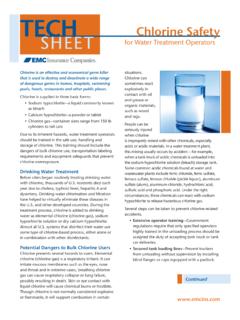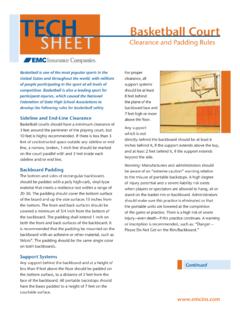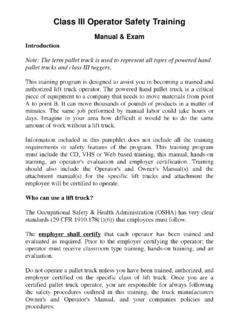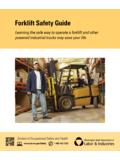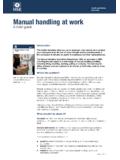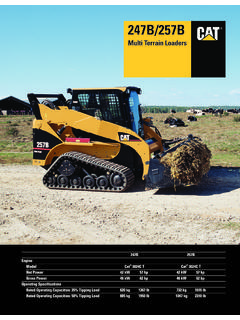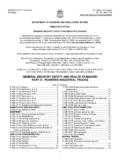Transcription of Loading Dock Safety
1 Loading dock SafetyThe Loading dock is one of the busiest and most dangerous areas in any warehouse. While the frequency of accidents in dock areas is usually lower than in other areas of the facility, the severity of injures related to Loading dock accidents can be very high. Injuries sustained when lift trucks fall from docks or when pedestrians are struck by a falling load can be very serious and even fatal. Data from the Bureau of Labor Statistics (BLS) indicates that an average of three workers are killed and many more are injured in Loading dock accidents each year. Using the proper restraining equipment, enforcing safe work practices and training employees on Loading dock hazards will help prevent these Restraint DevicesOne of the most serious hazards associated with Loading docks is trailer creep (also known as trailer walk or dock walk), which occurs when the rear wheels of the trailer move away from the dock while the trailer is being loaded or unloaded.
2 Trailer creep is affected by several factors, including: Weight and speed of the forklift entering the trailer (more weight or more speed increases the risk) Grade of the pavement where the trailer is parked (uphill grades decrease the risk) Softness of the trailer s suspension (air-ride trailers increase the risk) Whether the trailer has been dropped off (spotted) or is still connected to the semi-tractor To prevent the hazards associated with trailer creep, all trailers should be restrained during Loading and unloading operations. The most common form of restraint is wheel chocks, which are wedge-shaped blocks placed in front of the rear wheels of the trailer. When used correctly, wheel chocks prevent trailer creep by limiting the forward movement of the trailer.
3 Lack of traction between the chock and the pavement, often caused by rain, snow and ice, may cause the chock to slip, thereby reducing its effectiveness. dock areas should be frequently cleared of snow and ice to ensure good traction is maintained. Perhaps the biggest issue with wheel chocks is enforcing their use. Many companies assume that providing wheel chocks at each dock and posting signs reminding drivers to chock their tires is enough to prevent an accident. However, leaving this important Safety issue to the truck driver is not a safe practice. If chocks are being used, it is important for the forklift operator to verify that the chocks are in place before entering the trailer. This can be accomplished using windows, doors, mirrors or cameras.
4 Management should regularly inspect trailers to determine if chocks are being used and reinforce their importance with forklift operators who are not using them properly. Spare chocks should also be kept on hand in case they are damaged or vehicle restraint systems include rear impact guard restraint systems and automatic rear wheel engagement systems. While these systems vary from one manufacturer to another, they are all designed to be used in place of wheel chocks. However, wheel chocks should be available on docks where these systems are used in case the trailer is incompatible with the restraint. For example, if a trailer s rear impact guard is damaged, a rear impact guard restraint may be rendered useless.
5 All dock employees should be trained on the safe use and maintenance of restraint systems. : This material is designed and intended for general information purposes only, and is not intended, nor shall be construed or relied upon, as specific legal advice. Copyright Employers Mutual Casualty Company 2011. All rights reserved. Image 2010 JupiterImages Corporation. 6136 (8-11)Home Office: 717 Mulberry Des Moines, IA 50309 800-447-2295 dock SafetyEmployee TrainingEmployee training is an important part of reducing the risk of dock -related injuries. While most companies provide adequate training to forklift operators, many do not provide training to other employees who work in the area. Some items that should be addressed during Loading dock Safety training include: Pedestrians should not be allowed in trailers while a forklift is Loading or unloading, due to the potential crushing injury that may occur in such a tight space.
6 Employees should perform a visual inspection of the trailer prior to entry by a forklift. If floorboards are damaged, a forklift should not be driven into the trailer. Specific areas should be designated for the storage of used pallets, containers and trash. The stacked height of pallets should not exceed 8 feet per recommendations from the National Fire Protection Association (NFPA.) Forklift operators and pedestrians should take extra caution when handling large loads that obstruct the operator s view, since forklifts cannot drive in reverse while Loading a trailer. Employees should not climb on or jump from docks, and should not place any part of their bodies between the trailer and the dock door. If employees need to climb down into the dock area, ladders or stairs should be Edge ProtectionEmployees can also be injured when they fall from the edge of the Loading dock .
7 While this is generally not an issue when the doors are closed, many doors remain open during summer months to cool the building. To prevent employees from falling from the edge of the dock , screens or gates should be installed across the opening. Where these items are infeasible, stanchions and chains should be provided as a visual reminder of the dock edge. Stand-alone barriers and barriers built into dock levelers help prevent forklift operators from driving off the edge of a dock . Many companies choose to engage stand-alone equipment even when the dock door is closed, since even the strongest door likely will not stop a heavy forklift. Many forklift operators have been injured when they drove off the edge of an empty dock , and some operators have accidentally driven right through the overhead door.
8 dock LightingDue to the large volume of pedestrian and forklift traffic common to Loading docks, it is important that adequate lighting be available. Adequate lighting will reduce the risk of employees being struck by forklifts and will also make it easier to see spills and debris ( , nails from pallets, splinters). In addition to dock area lighting, lift trucks used to load and unload trailers should be equipped with spotlights. dock -mounted lights should be available to supplement lift truck spotlights, as well as to provide adequate lighting during manual Loading and unloading using pallet jacks, hand trucks or other material handling equipment. For Additional InformationCanadian Center for Occupational Safety and Health: OSH Answers Safety Hazards/Forklift TrucksOccupational Safety & Health Administration: Safety and Health Topics Powered Industrial Trucks Powered Industrial Trucks eTool

